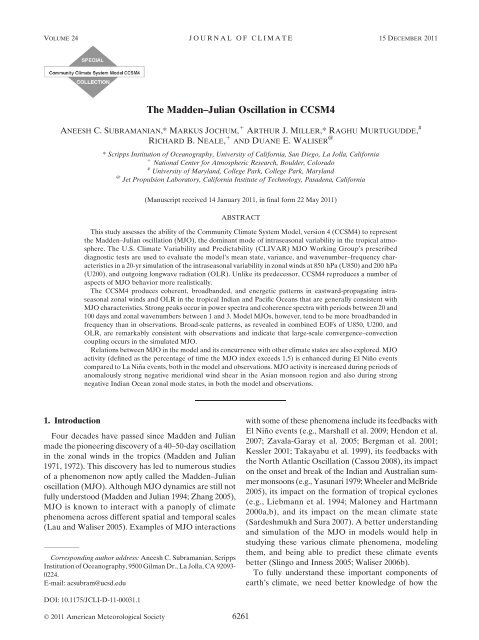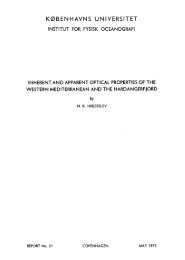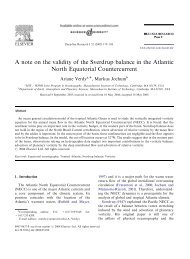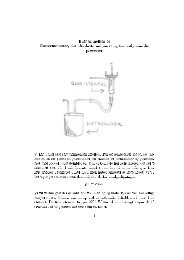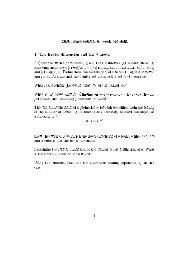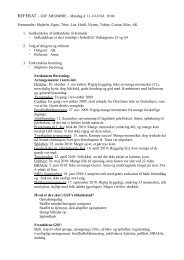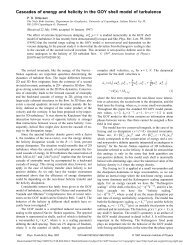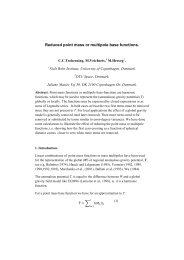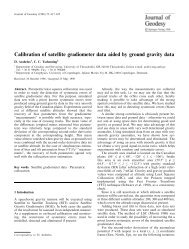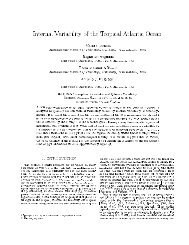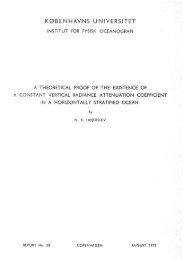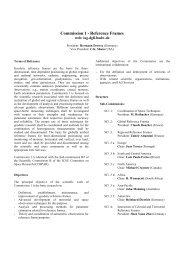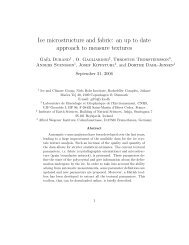The MaddenâJulian Oscillation in CCSM4
The MaddenâJulian Oscillation in CCSM4
The MaddenâJulian Oscillation in CCSM4
Create successful ePaper yourself
Turn your PDF publications into a flip-book with our unique Google optimized e-Paper software.
6262 JOURNAL OF CLIMATE VOLUME 24MJO <strong>in</strong>teracts with these components at various temporaland spatial scales (Lau and Waliser 2005). Yet, current climatemodels still have difficulty represent<strong>in</strong>g the MJO realistically.Numerous model <strong>in</strong>tercomparison studies of theirability to capture the MJO have been published (Sl<strong>in</strong>go et al.1996; Waliser et al. 2003; L<strong>in</strong> et al. 2006; Zhang et al. 2006;Sperber and Annamalai 2008; Kim et al. 2009), reveal<strong>in</strong>ghow GCMs cont<strong>in</strong>ue to struggle to represent MJO.Sl<strong>in</strong>go et al. (1996) showed <strong>in</strong> their study of the tropical<strong>in</strong>traseasonal variability us<strong>in</strong>g atmospheric GCMsimulations forced by observed monthly-mean sea surfacetemperature (SST) that the Atmospheric Model IntercomparisonProject (AMIP) models were unable to simulatethe observed spectral peak <strong>in</strong> the 30–70-day-periodband of the global (zonal wavenumber 1) equatorial200-hPa velocity potential. L<strong>in</strong> et al. (2006) analyzedMJO variability <strong>in</strong> 14 Coupled Model IntercomparisonProject phase 3 (CMIP3) models, elucidat<strong>in</strong>g that only 2models had MJO variance comparable to observationsbut that many other MJO features were lack<strong>in</strong>g realismeven <strong>in</strong> these models. Kim et al. (2009) studied a recentset of global models and noted that only two of them, thesuper-parameterized Community Atmosphere Model(SPCAM) and ECHAM4/Ocean Isopycnal Model(OPYC), yielded a respectable representation of MJO.<strong>The</strong> aforementioned multimodel studies attempted toprovide <strong>in</strong>sight <strong>in</strong>to what is important for MJO simulationby compar<strong>in</strong>g the different physical parameterizationsemployed by models of differ<strong>in</strong>g MJO verisimilitude. Acommon theme throughout these studies is that a goodMJO representation is <strong>in</strong>fluenced by the convection parameterizationemployed <strong>in</strong> the model, although manyother factors come <strong>in</strong>to play. As established global climatemodels cont<strong>in</strong>ue to be improved with improvedphysics, they need to be validated for their performance<strong>in</strong> represent<strong>in</strong>g MJO variability because of its importance<strong>in</strong> <strong>in</strong>fluenc<strong>in</strong>g other climate phenomena.Here we document how parameterizations <strong>in</strong> the NationalCenter for Atmospheric Research (NCAR) CommunityClimate System Model (CCSM) affect the modeledMJO activity <strong>in</strong> long-term climate simulations. <strong>The</strong> latestversion, <strong>CCSM4</strong>, has a novel deep convective momentumtransport scheme, which profoundly alters the behavior ofMJO events <strong>in</strong> the model. Our primary goal is to quantifythe characteristics of MJO activity <strong>in</strong> <strong>CCSM4</strong> accord<strong>in</strong>g tothe set of community diagnostics that has been developedto compare MJO simulations <strong>in</strong> climate models with observations[developed by the Climate Variability and Predictability(CLIVAR) Madden–Julian <strong>Oscillation</strong> Work<strong>in</strong>gGroup 2008 (CL-MJOWG08); Waliser et al. 2009).Recent work by Zhou et al. (2012) with a modifiedversion of CCSM3 showed that MJOs were more realisticwhen <strong>in</strong>clud<strong>in</strong>g a convective momentum transport termand a dilute plume approximation (DPA) <strong>in</strong> the convectiveparameterization scheme. Inclusion of the DPAimproves the correlation between <strong>in</strong>traseasonal convectiveheat<strong>in</strong>g and <strong>in</strong>traseasonal temperature, which iscritical for the buildup of the available potential energy.More realistic low-level background zonal w<strong>in</strong>ds over theIndo-Pacific warm pool improves the propagation speedsof <strong>in</strong>traseasonal variability <strong>in</strong> the convect<strong>in</strong>g systems.We will show that the MJO is further improved <strong>in</strong> <strong>CCSM4</strong>with 18 horizontal resolution compared to the previousversions of uncoupled CCSM studied by Zhang (2003)with the NCAR CCM3 us<strong>in</strong>g the modified convectionparameterization scheme of Zhang and McFarlane (1995)at 38 resolution with prescribed SST; by Kim et al. (2009)with an uncoupled Community Atmosphere Model, version3 (CAM3.5) at 28 resolution with prescribed SST;and by Zhou et al. (2012) with CCSM3.5 at 28 resolution.S<strong>in</strong>ce the MJO is found here to be well represented <strong>in</strong><strong>CCSM4</strong>, we also explore its <strong>in</strong>teraction with other climatephenomena on <strong>in</strong>terannual time scales. <strong>The</strong>se <strong>in</strong>cludeENSO, the Indian monsoon, and the Indian Oceanzonal mode (IOZM) of SST. We demonstrate that thesimulated MJO has key similarities with observed MJOfor each of these climate modes. S<strong>in</strong>ce the record lengthsare short, further analysis will be required to solidify thisrelationship <strong>in</strong> terms of causal l<strong>in</strong>kages.In section 2 we briefly describe the <strong>CCSM4</strong> modelused here, <strong>in</strong>dicat<strong>in</strong>g the primary changes <strong>in</strong> the modelsetup from its previous version. <strong>The</strong> various observationaldatasets used <strong>in</strong> this study for the comparison ofMJO <strong>in</strong> the model with those of nature are also presented.Section 3 conta<strong>in</strong>s the analysis of the modelMJO, focus<strong>in</strong>g on the structure and propagat<strong>in</strong>g featuresof the MJO <strong>in</strong> the model as compared to observations. Insection 4 we identify relations between the model MJOand several climate <strong>in</strong>dices from the model and observations.Section 5 summarizes the results.2. Model simulations and validation dataa. <strong>CCSM4</strong><strong>The</strong> CCSM is a general circulation climate model thatcouples the atmosphere, land, ocean, and sea ice components.Gent et al. (2011) gives an overview and a descriptionof the CCSM version 4 climate simulation with26 levels <strong>in</strong> the vertical, 0.98 31.258 horizontal atmosphereand land resolution, and nom<strong>in</strong>ally 18 ocean (withenhancement to 0.58 near the equator) and sea ice resolution.This version has numerous changes and improvementscompared to version 3, as briefly documented here.<strong>The</strong> core of the CAM version 4 has been changed fromthe spectral core used <strong>in</strong> CAM3 to the L<strong>in</strong>-Rood f<strong>in</strong>ite
15 DECEMBER 2011 S U B R A M A N I A N E T A L . 6263FIG. 1. A 10-yr slid<strong>in</strong>g w<strong>in</strong>dow variance of monthly-mean Niño-3.4 <strong>in</strong>dex for the 500-yr climatesimulation of <strong>CCSM4</strong>.volume core (L<strong>in</strong> 2004). <strong>The</strong> CAM4 is the sixth generationof the NCAR atmospheric GCM and has aga<strong>in</strong>been developed through a collaborative process of usersand developers <strong>in</strong> the Atmosphere Model Work<strong>in</strong>g Group(AMWG). In CAM4, changes to the moist physical representationscenter on enhancements to the exist<strong>in</strong>g Zhangand McFarlane (1995) deep convection parameterization.<strong>The</strong> calculation of convective available potential energy(CAPE) assumes an entra<strong>in</strong><strong>in</strong>g plume to provide the<strong>in</strong>-cloud temperature and humidity profiles used to determ<strong>in</strong>ebuoyancy and related cloud closure properties.<strong>The</strong> modification is based on the conservation of moistentropy and mix<strong>in</strong>g methods of Raymond and Blyth (1986,1992). It replaces the standard nonentra<strong>in</strong><strong>in</strong>g plume methodused <strong>in</strong> CAM3 with a DPA to <strong>in</strong>crease convection sensitivityto tropospheric moisture and to reduce the amplitudeof the diurnal cycle of precipitation over land.Mix<strong>in</strong>g occurs at all levels (not only at the cloud top) betweenthe lowest model level and the neutral buoyancylevel for a ris<strong>in</strong>g air parcel. Accord<strong>in</strong>g to DPA, air parcelsseek the neutral buoyancy level and their specific entropyis conserved dur<strong>in</strong>g the vertical motion. Mix<strong>in</strong>g betweenthe reference parcel and the free troposphere is dependenton an assumed entra<strong>in</strong>ment rate. <strong>The</strong> representationof the MJO should benefit from <strong>in</strong>creased sensitivity totropospheric moisture because the observed occurrenceof progressive premoisten<strong>in</strong>g is east of each MJO event’sconvect<strong>in</strong>g maxima (Benedict and Randall 2007; Bechtoldet al. 2008; L<strong>in</strong> et al. 2008). This process may more readilyoccur <strong>in</strong> the model because DPA may <strong>in</strong>hibit some deepconvection before the active phase of MJO and hencecause the right conditions for large organization of deepconvective systems <strong>in</strong>to the MJO.Subgrid-scale convective momentum transports (CMTs)have been added to the deep convection scheme follow<strong>in</strong>gGregory et al. (1997), which represents the compensationof CMTs by atmospheric subsidence. This was implemented<strong>in</strong> the model us<strong>in</strong>g the methodology of Richterand Rasch (2008). <strong>The</strong> CMT parameterization followsthe mass flux approach and decomposes the productu9w9, where u9 and w9 are unresolved perturbations tothe zonal and vertical velocities, respectively, <strong>in</strong>to threecomponents: updraft, downdraft, and environment [seeEq. (3) <strong>in</strong> Gregory et al. 1997]. CMT affects troposphericclimate ma<strong>in</strong>ly through changes to the Coriolis torque.<strong>The</strong>se changes result <strong>in</strong> improvement of the Hadley circulationdur<strong>in</strong>g northern w<strong>in</strong>ter and it reduces many ofthe model biases (Neale et al. 2008). For example, theannual mean, the tropical easterly bias, subtropical westerlybias, and the excessive Southern Hemisphere midlatitudejet, seen <strong>in</strong> CCSM3, are improved <strong>in</strong> CCSM3.5, asshown by Zhou et al. (2012). In comb<strong>in</strong>ation, these modificationsto the deep convection parameterization leadto significant improvements <strong>in</strong> the phase, amplitude, andspatial anomaly patterns of the modeled El Niño, alsodocumented by Neale et al. (2008).<strong>The</strong>re also have been a number of changes to theocean component of <strong>CCSM4</strong>, which are documented <strong>in</strong>Danabasoglu et al. (2012). For the tropical air–sea <strong>in</strong>terface,the only change of relevance is the use of observedbackground diffusivities, which significantly reduces thetropical SST biases, which <strong>in</strong> turn reduce the tropical
6264 JOURNAL OF CLIMATE VOLUME 24FIG. 2. (a) NCEP (20 yr) and (b) <strong>CCSM4</strong> (20 yr) annual mean zonal 850-hPa w<strong>in</strong>ds <strong>in</strong> m s 21 .Period used <strong>in</strong> the calculations for NCEP is 1981–2000. A 20-yr period used <strong>in</strong> the model isa comb<strong>in</strong>ation of the HENSO and LENSO 10-yr runs.precipitation biases (Jochum 2009). Jochum (2009) andRichter and Rasch (2008) show that vertical diffusivityand CMT changes, respectively, tend to have oppositesignedbut similar magnitude effects on annual meantropical precipitation. <strong>The</strong> analysis to f<strong>in</strong>d which effectdom<strong>in</strong>ates the other <strong>in</strong> improv<strong>in</strong>g <strong>in</strong>traseasonal variabilityis beyond the scope of this study, yet it would be an importantstudy to understand how the MJO is better representedand would help <strong>in</strong> improv<strong>in</strong>g the representationof the MJO further.<strong>The</strong> NCAR <strong>CCSM4</strong> group provided a 500-yr simulationas a control run under 1850 pre<strong>in</strong>dustrial conditions.Output from that run is saved as monthly means. S<strong>in</strong>cethe MJO has time scales comparable to that sampl<strong>in</strong>g, itwas necessary to rerun <strong>CCSM4</strong> and save the fields asdaily means. Because of computational resource limitations,we were unable to rerun the model for the entire500 yr. S<strong>in</strong>ce large ENSO events may <strong>in</strong>fluence the developmentand evolution of MJO, we decided to use twoextreme 10-yr periods of ENSO behavior dur<strong>in</strong>g the500-yr run and then comb<strong>in</strong>e the analysis results for thetwo periods. One period has the maximum ENSO variance,and the other period has the m<strong>in</strong>imum ENSOvariance dur<strong>in</strong>g the 500-yr base run. We treat the two 10-yrruns as <strong>in</strong>dependent realizations of MJO behavior andcompare them jo<strong>in</strong>tly (as a 20-yr model dataset) withNational Centers for Environmental Prediction (NCEP)observations, thereby avoid<strong>in</strong>g bias<strong>in</strong>g the results towardthe model’s response <strong>in</strong> one state of ENSO variability.Additionally, we exam<strong>in</strong>e differences <strong>in</strong> MJO behavior<strong>in</strong> the two extreme ENSO regimes <strong>in</strong> section 4.To establish two dist<strong>in</strong>ct ENSO regimes, we computethe ENSO Niño-3.4 <strong>in</strong>dex for the 500 yr from the CCSMbaserunmonthly-meanmodeloutput.<strong>The</strong>naslid<strong>in</strong>g10-yr w<strong>in</strong>dow is employed to compute a time-vary<strong>in</strong>gvariance for these 500 yr. <strong>The</strong> two 10-yr periods with thehighest and lowest variability of ENSO are then identified,as shown <strong>in</strong> Fig. 1. Each case conta<strong>in</strong>s roughly 2.5El Niño to La Niña transitions, with the amplitude ofENSO <strong>in</strong> the strong case be<strong>in</strong>g 2–3 times that of theweak variance case. <strong>The</strong> <strong>CCSM4</strong> model was re<strong>in</strong>itializedfrom the base run <strong>CCSM4</strong> for these periods (with perfectrestarts) and the output was saved as 1-day averagesto explore the high-frequency content of MJO <strong>in</strong> <strong>CCSM4</strong>.Saved fields <strong>in</strong>cluded zonal and meridional w<strong>in</strong>ds, verticalvelocity, specific humidity, relative humidity, temperature,geopotential, precipitation, and cloud fractionat all levels; plus net longwave, shortwave, latent and
15 DECEMBER 2011 S U B R A M A N I A N E T A L . 6265FIG. 3. (a) NCEP and (b) <strong>CCSM4</strong> variance (l<strong>in</strong>e contours) <strong>in</strong> zonal 850-hPa w<strong>in</strong>ds <strong>in</strong> m 2 s 22 and the percentageratio of the <strong>in</strong>traseasonal bandpassed (20–100 days) daily fields to the total variance (color contours). Period used <strong>in</strong>the calculations is 20 yr (1981–2000 for NCEP).sensible heat fluxes at the surface and large-scale (liquidplus ice) precipitation rate. Hereafter, when necessary,the two 10-yr simulations of <strong>CCSM4</strong> will be labeledHENSO for the high ENSO variability case and LENSOfor the low ENSO variability case. <strong>The</strong> comb<strong>in</strong>ed 20-yrrun forms the basis for our MJO analysis.b. Observational dataWe validate the MJO characteristics <strong>in</strong> the 20-yr CCSMsimulation aga<strong>in</strong>st the Advanced Very High ResolutionRadiometer (AVHRR) outgo<strong>in</strong>g longwave radiation(OLR) (Liebmann and Smith 1996), which is a proxy forconvective activity. We use ra<strong>in</strong>fall from the Climate PredictionCenter Merged Analysis of Precipitation (CMAP)(Xie and Ark<strong>in</strong> 1997) and the Global Precipitation ClimatologyProject (GPCP) (Huffman et al. 2001). <strong>The</strong>upper-tropospheric (200 hPa) and lower-tropospheric(850 hPa) zonal w<strong>in</strong>ds are from NCEP–NCAR reanalysisdata (Kalnay et al. 1996).3. MJO characteristics <strong>in</strong> <strong>CCSM4</strong>MJO diagnosticsWe adopt the CL-MJOWG08 strategy here andcompute diagnostics for both boreal summer and w<strong>in</strong>ter<strong>in</strong>traseasonal variability and mean state. <strong>The</strong> MJO bandis isolated by runn<strong>in</strong>g all fields through a 20–100-dayLanczos bandpass filter, follow<strong>in</strong>g Waliser et al. (2009).<strong>The</strong> 20–100-day Lanczos bandpass-filtered data are dom<strong>in</strong>atedby the MJO signal, although it could have relativelysmall equatorial Rossby (ER) wave signals <strong>in</strong> addition tothe MJO (Roundy et al. 2009). Although some previousworks have demonstrated that some of these waves aresystematically associated with the MJO, other equatorialRossby waves are <strong>in</strong>dependent from the MJO andmight <strong>in</strong>fluence some results (Kiladis et al. 2009).As an important start<strong>in</strong>g po<strong>in</strong>t, the mean state of therelevant variables is first validated. We did several comparisonsof background state dur<strong>in</strong>g the 20-yr model runversus observed climatology, and our results are largelyconsistent with those of Zhou et al. (2012) for CCSM3.5.For example, a comparison of the mean zonal 850-hPaw<strong>in</strong>ds <strong>in</strong> NCEP (observations) with the mean zonal850-hPa w<strong>in</strong>ds for the CCSM runs reveals that the modelsimulations have structures that are comparable to theobserved w<strong>in</strong>ds from NCEP. While the magnitude of themean easterlies <strong>in</strong> the Pacific is 50% greater than observed,the westerlies over the Maritime Cont<strong>in</strong>ent arenearly as strong as observed (Fig. 2). This extension ofthe zonal westerlies across the Maritime Cont<strong>in</strong>ent can
6266 JOURNAL OF CLIMATE VOLUME 24FIG. 4. (a) National Oceanic and Atmospheric Adm<strong>in</strong>istration (NOAA) AVHRR satellite OLR and (b) <strong>CCSM4</strong>variance (l<strong>in</strong>e contours) OLR <strong>in</strong> W 2 m 24 and the percentage ratio of the variance <strong>in</strong> the <strong>in</strong>traseasonal bandpassed(20–100 days) daily OLR fields to the total variance (color contours). Period used <strong>in</strong> the calculations is 20 yr (1981–2000 for NCEP).favorably <strong>in</strong>fluence the propagation of the MJO <strong>in</strong>to thewestern Pacific, as expla<strong>in</strong>ed by Inness et al. (2003) forthe third climate configuration of the Met Office UnifiedModel (HadCM3) and Zhou et al. (2012) for CCSM3.5.1) LEVEL 1 DIAGNOSTICSLevel 1 diagnostics assess the dom<strong>in</strong>ant spatial andtemporal scales as well as propagation direction of convectionand 850-hPa zonal w<strong>in</strong>d. <strong>The</strong>se diagnostics providea general evaluation of the broadband <strong>in</strong>traseasonalvariability associated with MJO.We first consider the w<strong>in</strong>ter 20–100-day variance ofthe zonal 850-hPa w<strong>in</strong>ds. <strong>The</strong> percentage of <strong>in</strong>traseasonalvariance of zonal 850-hPa w<strong>in</strong>ds (color contours of Fig. 3)<strong>in</strong> NCEP is comparable to that of the model simulation.<strong>The</strong> structure of the <strong>in</strong>traseasonal variance pattern <strong>in</strong> themodel is consistent with MJO characteristics, bear<strong>in</strong>gm<strong>in</strong>ima <strong>in</strong> zonal w<strong>in</strong>d variance along the equator <strong>in</strong> boththe Indian and Pacific Oceans and a maximum varianceover the Maritime Cont<strong>in</strong>ent. <strong>The</strong> total variance of thesew<strong>in</strong>ds <strong>in</strong> <strong>CCSM4</strong> (l<strong>in</strong>e contours <strong>in</strong> Fig. 3) is also reasonablyconsistent with observations. Note, however, that atleast at the air–sea <strong>in</strong>terface, the Quick Scatterometer(QuikSCAT) w<strong>in</strong>d observations suggest that <strong>in</strong> the equatorialeast Pacific, NCEP w<strong>in</strong>ds are approximately 30%too weak (Large and Yeager 2009).Total OLR variance <strong>in</strong> <strong>CCSM4</strong>, shown by the l<strong>in</strong>econtours <strong>in</strong> Fig. 4, tends to be higher than <strong>in</strong> observationsof AVHRR satellite OLR, especially over the MaritimeCont<strong>in</strong>ent. <strong>The</strong> percentage of w<strong>in</strong>ter 20–100-day variance<strong>in</strong> model OLR has comparable values to observationsover the Maritime Cont<strong>in</strong>ent and <strong>in</strong> the western equatorialPacific. However, <strong>in</strong> the MJO <strong>in</strong>itiation region <strong>in</strong>the central Indian Ocean, the model has a smaller fractionof MJO OLR variance. Taken together with the zonalw<strong>in</strong>d results, this may be <strong>in</strong>dicative of a weaker coupl<strong>in</strong>gbetween the dynamic fields and convection <strong>in</strong> the MJO<strong>in</strong>itiation regions of the Indian Ocean.Hovmöller diagrams for zonal w<strong>in</strong>ds (averaged from58N to58S) are used to visually illustrate the eastwardpropagation of MJO signals. We chose one year fromthe model run with strong MJO activity and compared itto one observed year (1997) with a MJO to highlight thepropagation characteristics (Fig. 5). <strong>The</strong>se years both <strong>in</strong>cludedLa Niña events, when the western tropical PacificSST was anomalously warm. In the model, eastward
15 DECEMBER 2011 S U B R A M A N I A N E T A L . 6267FIG. 5. Hovmöller plot of the <strong>in</strong>traseasonal (20–100 days) zonal 850-hPa w<strong>in</strong>ds of (a) NCEP <strong>in</strong> 1997 compared tothat of <strong>in</strong>traseasonal zonal 850-hPa w<strong>in</strong>ds of year 3 of the (b) <strong>CCSM4</strong> run. <strong>The</strong> arrow, which represents 8 m s 21 ,ismeant to guide the eye and shows eastward propagation.propagation is evident dur<strong>in</strong>g w<strong>in</strong>ter at speeds of about5–7 m s 21 , which is comparable to the observed phasespeeds. Events <strong>in</strong> both the model and observations orig<strong>in</strong>ate<strong>in</strong> the Indian Ocean region and propagate aroundthe globe. As also seen <strong>in</strong> observations, these events tendto weaken over the Maritime Cont<strong>in</strong>ent and strengthenaga<strong>in</strong> <strong>in</strong> the western Pacific Ocean. Similar to observations,albeit more pronounced, the model MJO eastwardpropagat<strong>in</strong>gactivity <strong>in</strong> summer months is much weakerthan <strong>in</strong> w<strong>in</strong>ter.Power spectra of the wavenumber–frequency characteristicsof observed w<strong>in</strong>ter MJO reveal a dom<strong>in</strong>antpeak for zonal wavenumber 1 and for a period of 60days, with a broadbanded structure that extends to zonalwavenumbers 2 and 3 over periods of 30–80 days (Fig. 6).<strong>The</strong> model conta<strong>in</strong>s peaks <strong>in</strong> this band; however, thedom<strong>in</strong>ant peak at 60 days is somewhat stronger andmore broadbanded than observations, and additionalpeaks occur at higher frequencies, suggest<strong>in</strong>g that themodel MJO is not as coherent as observations. Overall,<strong>CCSM4</strong> conta<strong>in</strong>s significant eastward-propagat<strong>in</strong>g energy<strong>in</strong> the same frequency range for wavenumbers <strong>in</strong>the MJO band dur<strong>in</strong>g the w<strong>in</strong>ter season, but the signalshave more energy than observations. Also, the <strong>CCSM4</strong>OLR does not have as strong of a peak <strong>in</strong> spectral powercompared to observations (Fig. 6). <strong>The</strong> peak <strong>in</strong> the spectralpower of the <strong>CCSM4</strong> OLR is at higher frequenciesthan the <strong>in</strong>traseasonal band. This is consistent with thef<strong>in</strong>d<strong>in</strong>gs discussed <strong>in</strong> later sections that the dynamicalconvective coupl<strong>in</strong>g <strong>in</strong> <strong>CCSM4</strong> is weaker than that <strong>in</strong>nature. <strong>The</strong>se spectra for <strong>CCSM4</strong> show enhanced andmore realistic energy at longer periods <strong>in</strong> the MJO bandcompared to frequency–wavenumber spectra computedby Zhang (2003) for CCM3, which exhibit dom<strong>in</strong>ant peaksat approximately 40 days and zonal wavenumber 1.2) LEVEL 2 DIAGNOSTICSLevel 2 diagnostics assess the coupl<strong>in</strong>g between thedynamic and thermodynamic variables. In addition tos<strong>in</strong>gle-variable spectral calculations, cross-spectral calculationsare computed to quantify the coherence andphase relationships between different variables. <strong>The</strong> crossspectralplots demonstrate that the thermodynamic anddynamic effects are coupled.Figure 7 shows the coherence squared and the phasebetween equatorial OLR and 850-hPa zonal w<strong>in</strong>ds forthe symmetric components of the two fields (Hendon andWheeler 2008). <strong>The</strong> symmetric component physically representsthe symmetric dynamics about the equator, whichis a first-order characteristic of the observed MJO. <strong>The</strong> leftpanels show the spectrum across a broad range of scales,while the right panels show a more detailed view of thescales of the MJO.Observations exhibit a high degree of coherence andan approximately 908 phase lag between convection and850-hPa w<strong>in</strong>ds for zonal wavenumbers 1–3 <strong>in</strong> the 30–80-day band (Figs. 7a,b). Although climate models arewell known to have difficulty simulat<strong>in</strong>g this feature
6268 JOURNAL OF CLIMATE VOLUME 24FIG. 6. November–April wavenumber–frequency spectra of 108N–108S averaged daily zonal 850-hPa w<strong>in</strong>ds of (a)NCEP (1981–2000) and (b) <strong>CCSM4</strong> (20 yr of HENSO and LENSO runs), and daily OLR fields of (c) NOAA satelliteOLR (1981–2000) and (d) <strong>CCSM4</strong>. Individual spectra were calculated for each year and then averaged over 20 yr ofdata. Only the climatological seasonal cycle and time mean for each November–April segment were removed beforecalculation of the spectra. Units for the zonal w<strong>in</strong>d spectrum are m 2 s 22 per frequency <strong>in</strong>terval per wavenumber<strong>in</strong>terval. <strong>The</strong> bandwidth is (180 day) 21 .(e.g., Zhang et al. 2006; Zhou et al. 2012), <strong>CCSM4</strong> exhibitsstrong coherence <strong>in</strong> this low-wavenumber band,with lags similar to observations. However, for wavenumber1, model coherency peaks at higher frequenciesnear 30-day periods compared to the 40-day peak forobservations (Figs. 7c,d). This modeled coherency relationsuggests that convectively coupled MJOs occur <strong>in</strong> themodel for wavenumber 1. <strong>The</strong> model’s spread of coherency<strong>in</strong>to higher frequencies at wavenumber 1,however, suggests that more l<strong>in</strong>ear Kelv<strong>in</strong> wave activity,with a convective signature, is present <strong>in</strong> <strong>CCSM4</strong> than <strong>in</strong>observations (Roundy 2008). To dist<strong>in</strong>guish whether thecoherency peak at wavenumber 1 is due to a simple Kelv<strong>in</strong>wave, Fig. 8 shows the antisymmetric part of the coherencyrelationship for the MJO band, which shouldhave no impr<strong>in</strong>t of a l<strong>in</strong>ear Kelv<strong>in</strong> wave. Observationsreveal significant coherency (0.15–0.35) for wavenumber1. <strong>The</strong> model also has significant coherency (0.05–0.15)
15 DECEMBER 2011 S U B R A M A N I A N E T A L . 6269FIG. 7. Coherence squared (colors) and phase lag (vectors) between zonal w<strong>in</strong>ds at 850-hPa w<strong>in</strong>ds and OLR are shownfor (a) NCEP w<strong>in</strong>ds and satellite OLR and (c) <strong>CCSM4</strong> w<strong>in</strong>ds and OLR; (b) and (d) are expanded views of the MJOrelevantparts of the spectra. Only the symmetric spectra are shown here. Cross spectra are calculated us<strong>in</strong>g daily datadur<strong>in</strong>g all seasons on 256-day-long segments, with consecutive segments overlapp<strong>in</strong>g by 206 days. Colors represent coherencesquared between OLR and U850, and vectors represent the phase by which w<strong>in</strong>d anomalies lag OLR anomalies,<strong>in</strong>creas<strong>in</strong>g <strong>in</strong> the clockwise direction. A phase of 08 is represented by a vector directed upward. Dispersion curves for the(n 521) Kelv<strong>in</strong>, n 5 1ER,and(n 5 1) <strong>in</strong>ertia-gravity waves correspond<strong>in</strong>g to three equivalent depths (h 5 12, 25, and50 m) <strong>in</strong> the shallow-water equations are overlaid (black contours). MJO is def<strong>in</strong>ed as the spectral components with<strong>in</strong>zonal wavenumbers 1–3 and hav<strong>in</strong>g periods of 20–80 days, as marked by the black box <strong>in</strong> the right panels.<strong>in</strong> this band, although somewhat weaker than observations.This antisymmetric structure is clearly <strong>in</strong>dicativeof convectively coupled MJO behavior atwavenumber 1.At wavenumbers 2 and 3 <strong>in</strong> Figs. 7c,d, <strong>CCSM4</strong> hasmuch lower convergence–convection coherency <strong>in</strong> theMJO 40–80-day-period band than observations. Instead,<strong>CCSM4</strong> exhibits high convergence–convection coherency
6270 JOURNAL OF CLIMATE VOLUME 24FIG. 8. Antisymmetric spectrum of coherence squared (colors) and phase lag (vectors) between zonal w<strong>in</strong>ds at850-hPa w<strong>in</strong>ds and OLR are shown for (a) NCEP w<strong>in</strong>ds and satellite OLR and (b) <strong>CCSM4</strong> w<strong>in</strong>ds and OLR asexpanded views of the MJO-relevant parts of the spectra. Cross spectra are calculated us<strong>in</strong>g daily data dur<strong>in</strong>g allseasons on 256-day-long segments, with consecutive segments overlapp<strong>in</strong>g by 206 days. Colors represent coherencesquared between OLR and U850, and vectors represent the phase by which w<strong>in</strong>d anomalies lag OLR anomalies,<strong>in</strong>creas<strong>in</strong>g <strong>in</strong> the clockwise direction. A phase of 08 is represented by a vector directed upward. MJO is def<strong>in</strong>ed as thespectral components with<strong>in</strong> zonal wavenumbers 1–3 and hav<strong>in</strong>g periods of 20–80 days as marked by the black box <strong>in</strong>the right panels.for these two wavenumbers at 10–15-day periods, whichis is <strong>in</strong>dicative of Kelv<strong>in</strong> waves bear<strong>in</strong>g a convectivesignature, s<strong>in</strong>ce the coherence falls along the l<strong>in</strong>eardispersion curves. <strong>The</strong> antisymmetric part of the modelspectrum (Fig. 8) has no significant coherence at theseperiods and wavenumbers, support<strong>in</strong>g this <strong>in</strong>terpretation.This part of the response is associated with <strong>in</strong>traseasonaloscillations that travel at speeds of 10–22 m s 21 , whichare faster than the typical observed MJO phase speed of5ms 21 . This weakly energetic and fast propagation atwavenumbers 2 and 3 <strong>in</strong> <strong>CCSM4</strong> may be associated witha lack of coupl<strong>in</strong>g between MJO and oceanic Kelv<strong>in</strong>waves <strong>in</strong> the central equatorial Pacific, which Roundy andKravitz (2009) identified as an important mechanism forslow<strong>in</strong>g and amplify<strong>in</strong>g higher-wavenumber-observedMJO <strong>in</strong> this region.<strong>The</strong> faster phase speed of MJO <strong>in</strong> CCSM is also evident<strong>in</strong> Fig. 9b, which shows the lag correlation betweenthe convection and the dynamic w<strong>in</strong>ds for observationsand the model. Model MJO activity tends to propagateto the Maritime Cont<strong>in</strong>ent, where it breaks up and thenreorganizes over the western Pacific and cont<strong>in</strong>ues propagat<strong>in</strong>gacross the Pacific slightly faster and even furtherthan observations suggest.We next use the Wheeler and Hendon (2004, hereafterWH04) technique to extract the dom<strong>in</strong>ant MJOspatial and temporal modes. Comb<strong>in</strong>ed EOFs (CEOFs),us<strong>in</strong>g OLR, U850, and U200, each bandpassed to the20–100-day-period band, are computed. This multivariateapproach isolates the convective and barocl<strong>in</strong>ic zonalw<strong>in</strong>d signature of the MJO. We specifically focus on theevaluation of 1) the vertical barocl<strong>in</strong>ic structure <strong>in</strong> thew<strong>in</strong>ds and the lag <strong>in</strong> OLR and convection, with the w<strong>in</strong>dsdepict<strong>in</strong>g a mov<strong>in</strong>g convection and convergence system;2) the evolution of the MJO life cycle <strong>in</strong> the modelsimulations; and 3) the MJO life cycle composite depict<strong>in</strong>gthe various phases <strong>in</strong> the MJO evolution withrespect to convection and the convergence zone.<strong>The</strong> two lead<strong>in</strong>g modes <strong>in</strong> both the model and observationscorrespond to MJO patterns and time scales.Figure 10 shows the 158N–158S average of the <strong>CCSM4</strong>MJO CEOFs 1 and 2 for all three variables. Comparedto the observed modes shown <strong>in</strong> Fig. 11, mode 2 fromobservations corresponds to mode 1 of the <strong>CCSM4</strong>. <strong>The</strong>longitud<strong>in</strong>al location of the maxima, m<strong>in</strong>ima, and zerocross<strong>in</strong>gs of all three variables correspond well betweenthe model and observations. Likewise, observationalmode 1 corresponds well to the structures seen <strong>in</strong> mode 2of the CCSM. <strong>The</strong> magnitudes of the CEOFs <strong>in</strong> themodel are about 40% smaller than the same <strong>in</strong> the observedfields. We conclude that <strong>in</strong> this period band, MJOphas<strong>in</strong>g between physical variables <strong>in</strong> <strong>CCSM4</strong> is remarkablyconsistent with observations but are weaker <strong>in</strong>magnitude. <strong>The</strong> partition<strong>in</strong>g of variance <strong>in</strong> the comb<strong>in</strong>edEOF analysis is as follows: OLR (18%), U200 (37%),and U850 (50%) for the first two comb<strong>in</strong>ed EOFs. <strong>The</strong>
15 DECEMBER 2011 S U B R A M A N I A N E T A L . 6271FIG. 10. All-season multivariate (a) first and (b) second CEOFmodes of 20–100-day 158S–158N averaged zonal w<strong>in</strong>d at 850 and200 hPa, and OLR from the 20-yr <strong>CCSM4</strong> run. Total varianceaccounted for by each mode is shown <strong>in</strong> parenthesis at the top ofeach panel.FIG. 9. November–April lag–longitude diagram of 108N–108Saveraged <strong>in</strong>traseasonal OLR anomalies (colors) and <strong>in</strong>traseasonal850-hPa zonal w<strong>in</strong>d anomalies (contours) correlated aga<strong>in</strong>st <strong>in</strong>traseasonalOLR at the Indian Ocean reference box (108S–58N,758–1008E) for (a) observations and (b) <strong>CCSM4</strong>.variance expla<strong>in</strong>ed by the pr<strong>in</strong>cipal components (PCs) <strong>in</strong>dividuallyis as follows: PC1—OLR (10%), U200 (21%),and U850 (26%); and PC2—OLR (8%), U200 (16%),and U850 (24%). This too is remarkably consistent withthe observed values of Waliser et al. (2009), namely,PC1_obs—OLR (13%), U200 (22%), and U850 (32%);and PC2_obs—OLR (16%), U200 (24%), and U850(23%).<strong>The</strong> lag correlation between PC1 and PC2 providesa measure of temporal coherency for the eastwardpropagat<strong>in</strong>gMJO. <strong>The</strong>se are calculated for year-roundfields for <strong>CCSM4</strong> and shown <strong>in</strong> Fig. 12a. <strong>The</strong> familiarS shape found <strong>in</strong> observations occurs (Waliser et al.2009), with peak correlations of roughly 0.6 occurr<strong>in</strong>g at68-day lags <strong>in</strong> <strong>CCSM4</strong> compared to a peak of 0.7 at610-day lags <strong>in</strong> observations. This <strong>in</strong>dicates the dom<strong>in</strong>antperiod is roughly 32 days <strong>in</strong> the model but roughly40 days <strong>in</strong> observations, consistent with the higher powerseen at high frequencies <strong>in</strong> <strong>CCSM4</strong> <strong>in</strong> the power spectraof Fig. 6. <strong>The</strong> phase relationship <strong>in</strong>dicates that the multivariateEOF1 and EOF2 are a quadrature pair. Thispair of lead<strong>in</strong>g EOFs represents coherent eastward propagationof MJO. It is a well-known challenge for GCMsto properly represent this coherent quadrature pair.Further, to verify whether the extracted MJO modes area physically mean<strong>in</strong>gful mode of variability and are dist<strong>in</strong>ctfrom noise, we project the lead<strong>in</strong>g EOFs derivedfrom filtered data onto unfiltered data (after only remov<strong>in</strong>gthe seasonal cycle). <strong>The</strong> power spectrum of the unfilteredPCs, shown <strong>in</strong> Fig. 12b, yields a prom<strong>in</strong>ent peak at MJOtime scales, very similar to Waliser et al. (2009) exceptfor the higher energy <strong>in</strong> the model spectral ‘‘shoulder’’at 20–30-day periods. This <strong>in</strong>creases our confidence <strong>in</strong> thediagnostics that the modes of variability obta<strong>in</strong>ed are<strong>in</strong>deed mean<strong>in</strong>gful.<strong>The</strong> two lead<strong>in</strong>g multivariate EOFs can also be usedto derive a composite MJO life cycle for boreal summeror w<strong>in</strong>ter, follow<strong>in</strong>g WH04. <strong>The</strong> composite is constructedby select<strong>in</strong>g full fields of U850, U200, and OLR dur<strong>in</strong>gthe time <strong>in</strong>tervals when MJO is strongly excited. <strong>The</strong>amplitude of the MJO is def<strong>in</strong>ed by PC1 2 1 PC2 2 after
6272 JOURNAL OF CLIMATE VOLUME 24FIG. 11. All-season multivariate (a) first and (b) second CEOFmodes of 20–100-day 158S–158N averaged zonal w<strong>in</strong>d at 850 and200 hPa from NCEP, and OLR from the NOAA satellite for 1980–99. Total variance accounted for by each mode is shown <strong>in</strong> parenthesiesat top of each panel.PC1 and PC2 are normalized to unit standard deviation.<strong>The</strong> time <strong>in</strong>tervals for the composite fields are def<strong>in</strong>ed astimes when the MJO <strong>in</strong>dex exceeds 1.5 (Fig. 18). <strong>The</strong>amplitudes for the MJO <strong>in</strong>dex dur<strong>in</strong>g the two modeltime periods HENSO and LENSO are shown (Fig. 18).<strong>The</strong> phase of the MJO is def<strong>in</strong>ed as atan(PC2/PC1). Foreach of the eight phases, composites are generated byaverag<strong>in</strong>g across all days that exceed the specified amplitudethreshold. <strong>The</strong> composite life cycle for the borealw<strong>in</strong>ter MJO <strong>in</strong> the <strong>CCSM4</strong> simulation is shown <strong>in</strong> Fig. 13.<strong>The</strong> same for observations is shown <strong>in</strong> Fig. 14.In general, <strong>CCSM4</strong> generates a realistic succession ofphases associated with MJO (Fig. 13), very similar tothose from observations (Fig. 14) <strong>in</strong> many respects. <strong>The</strong>model phases differ from those <strong>in</strong> observations <strong>in</strong> a fewdetails. <strong>The</strong> convection <strong>in</strong> phase 3 <strong>in</strong> the model compositeoccurs off the equator rather than over it as <strong>in</strong>observations (consistent with the variance plots of OLR<strong>in</strong> Fig. 4). From phase 3 to phase 5, westerlies <strong>in</strong>crease <strong>in</strong>the eastern Indian Ocean and <strong>in</strong>tensify convection overthe Maritime Cont<strong>in</strong>ent, but not as strongly as observations.<strong>The</strong> <strong>in</strong>tensity of the OLR <strong>in</strong> the model is alsolower and more widespread <strong>in</strong> model phases 3–6 comparedto those <strong>in</strong> observations. Compared to a similarcomposite shown by Zhou et al. (2012) for CCSM3.5,<strong>CCSM4</strong> exhibits a more realistic OLR pattern over theIndian Ocean region dur<strong>in</strong>g the <strong>in</strong>itiation phase and morecoherent propagat<strong>in</strong>g components across the MaritimeCont<strong>in</strong>ent. Likewise, the phase composites for <strong>CCSM4</strong>exhibit much more organized patterns of MJO propagationthan found by Zhang (2003) for CCM3.We next consider the nature of the precipitation <strong>in</strong> the<strong>in</strong>traseasonal band. Figure 15 shows the variance <strong>in</strong> the<strong>in</strong>traseasonal precipitation from the model and GPCPobservations. <strong>The</strong> model precipitation variance is about50% greater than that <strong>in</strong> observations, suggest<strong>in</strong>g thatthe convectively coupled <strong>in</strong>traseasonal bands of MJOgenerate excessive precipitation <strong>in</strong> the model. <strong>The</strong> <strong>in</strong>traseasonalvariance of the diabatic heat<strong>in</strong>g caused byconvection parameterized <strong>in</strong> the model has a spatialpattern that is similar to the variance of the precipitation(Fig. 16). This supports the idea that the excessive precipitation<strong>in</strong> the model is due to large-scale convectivesystems (such as the MJO) <strong>in</strong> the <strong>in</strong>traseasonal band. Inthe Indian Ocean <strong>in</strong>itiation region of MJO, dur<strong>in</strong>g phases2 and 3 of the composite MJO, the ratio of large-scaleprecipitation resolved by the model to the Zhang–McFarlane parameterized precipitation is shown <strong>in</strong> Fig. 17.Roughly 30%–35% of the precipitation dur<strong>in</strong>g MJO<strong>in</strong>itiation <strong>in</strong> the Indian Ocean is resolved by the modeland hence is consistent with a large-scale <strong>in</strong>traseasonalconvective system propagat<strong>in</strong>g rather than the small-scaleconvection dom<strong>in</strong>at<strong>in</strong>g the precipitation.In summary, <strong>CCSM4</strong> exhibits an energetic eastwardpropagat<strong>in</strong>gsignal with MJO-like properties <strong>in</strong> the 20–100-day-period band and the 1–3 zonal wavenumberband. <strong>The</strong> model MJO has somewhat stronger amplitudesand faster propagation speeds than observations. Forwavenumber 1, cross-spectral measures of convergence–convection relationships <strong>in</strong> the MJO period band aresimilar <strong>in</strong> strength to observations and <strong>in</strong>dicate convectivelycoupled MJO is occurr<strong>in</strong>g. <strong>The</strong> more broadbandedcoherency <strong>in</strong> frequency suggests that additionalactivity associated with Kelv<strong>in</strong> waves with a convectivesignature also occurs <strong>in</strong> the model. This <strong>in</strong>terpretation iseven more evident for wavenumbers 2 and 3, which exhibitconvergence–convection coherency for high frequenciesthat are outside the MJO band.Compared to other global coupled models, <strong>CCSM4</strong>exhibits relatively high skill <strong>in</strong> simulat<strong>in</strong>g these <strong>in</strong>traseasonaloscillations. As compared to the models analyzed<strong>in</strong> Kim et al. (2009), <strong>CCSM4</strong> has pronouncedenergy <strong>in</strong> the MJO band and is comparable to the bestmodels listed, namely, ECHAM4 and SPCAM. Also,the period and energy of the simulated ENSOs <strong>in</strong> <strong>CCSM4</strong>are much improved compared to its previous CCSM versions.As shown <strong>in</strong> Kim et al. (2009), the period withmaximum energy has shifted from 200 days for CCSM3.5to the <strong>in</strong>traseasonal period of 70 days for <strong>CCSM4</strong>.
15 DECEMBER 2011 S U B R A M A N I A N E T A L . 6273FIG. 12. (a) Lag correlation between PC1 and PC2 of multivariate EOF analysis of the <strong>in</strong>traseasonalzonal w<strong>in</strong>ds at 850 and 200 hPa, and <strong>in</strong>traseasonal OLR anomalies from the<strong>CCSM4</strong> run and observations. (b) Power spectral density of the <strong>CCSM4</strong> PC projected onto theunfiltered data. Dashed l<strong>in</strong>es show the red noise spectrum and upper 90% and 95% confidencelimits on this red noise spectrum.Additionally, the <strong>in</strong>traseasonal wavenumber peak hasbroadened to <strong>in</strong>clude wavenumbers 1–3 from ma<strong>in</strong>ly be<strong>in</strong>gat wavenumber 1, with <strong>in</strong>traseasonal spectral powerlevels hav<strong>in</strong>g <strong>in</strong>creased by about 50% <strong>in</strong> <strong>CCSM4</strong> comparedto CCSM3.5. Besides improved parameterizations,some of the improvement over the results of Kim et al.(2009) is likely due to the higher resolution used here(18 vs 28) and the <strong>in</strong>clusion of full ocean coupl<strong>in</strong>g (ratherthan prescribed SST).S<strong>in</strong>ce the phase of the OLR and w<strong>in</strong>ds <strong>in</strong> CCSM correspondwell with the structure of MJO, the simulationsof MJO can therefore be analyzed for relations withother climate phenomena, such as ENSO and the monsoons,to attempt to understand their dynamical <strong>in</strong>teractions.We next execute some prelim<strong>in</strong>ary attempts ataddress<strong>in</strong>g these issues.4. Relations of MJO to other climate phenomenaa. MJO–ENSO relationsEl Niño–Southern <strong>Oscillation</strong> is the strongest <strong>in</strong>terannuallyvary<strong>in</strong>g phenomenon <strong>in</strong> the tropical coupledocean–atmosphere system. <strong>The</strong> MJO is the strongest<strong>in</strong>traseasonal-vary<strong>in</strong>g phenomenon <strong>in</strong> the tropical coupledocean–atmosphere system. Although both of these phenomenahave most of their energy <strong>in</strong> widely separatedtime scales, they have been shown to <strong>in</strong>teract and modulateeach other s<strong>in</strong>ce both of them <strong>in</strong>volve large-scaletropical convection, large-scale atmospheric circulationchanges, and teleconnections to other global weather phenomena(Kessler and Kleeman 2000; Hendon et al. 2007;Neale et al. 2008; Marshall et al. 2009; Pohl et al. 2010).<strong>The</strong> strength of the MJO varies year to year, and someof this variability <strong>in</strong> the west Pacific has been l<strong>in</strong>ked toENSO. For example, equatorial zonal w<strong>in</strong>d variabilityon MJO time scales has been noted to affect the subsequentdevelopment of ENSO events (Bergman et al.2001; Kessler 2001; Hendon et al. 2007; Tang and Yu2008). <strong>The</strong> impact of ENSO on MJO variability, however,is less clear. L<strong>in</strong> and Li (2008) suggested that MJO activityis sensitive to whether ENSO is <strong>in</strong> a develop<strong>in</strong>g ordecay<strong>in</strong>g state dur<strong>in</strong>g summer. Roundy and Kravitz (2009)also showed a sensitivity of MJO behavior to oceanic statebecause MJO <strong>in</strong>teractions with oceanic Kelv<strong>in</strong> wavesassociated with ENSO <strong>in</strong> the western equatorial Pacific.<strong>The</strong> possible relationships between MJO and ENSOstates are explored here by relat<strong>in</strong>g the periods whenMJO is ‘‘active’’ (MJO <strong>in</strong>dex exceeds 1.5) to three statesof ENSO, def<strong>in</strong>ed by the Niño-3.4 <strong>in</strong>dex exceed<strong>in</strong>g a
6274 JOURNAL OF CLIMATE VOLUME 24FIG. 13. Composite November–April 20–100-day OLR (color, <strong>in</strong> W m 22 ) and 850-hPa w<strong>in</strong>danomalies (vectors) as a function of MJO phase for the 20-yr CCSM run. Reference vector <strong>in</strong>units of m s 21 is shown at the top right. Number of days used to generate the composite for eachphase is shown at the bottom right of each panel.threshold for at least 3 months (El Niño when the <strong>in</strong>dexexceeds 0.5 and La Niña when the <strong>in</strong>dex is less than 20.5and neutral otherwise). Figure 18 shows the results forboth the model run and observations, along with 1) thepercentage of time MJO is active dur<strong>in</strong>g the ENSO statesand 2) the average strength of MJO dur<strong>in</strong>g the ENSOstates when MJO is active. Consider<strong>in</strong>g the El Niño andtheLaNiña states, both the model and observations havea tendency to produce enhanced MJO activity dur<strong>in</strong>g thewarm events compared to cold ENSO events. <strong>The</strong> modelMJO also tends to produce lower-amplitude activity dur<strong>in</strong>gcold events but this relation does not occur <strong>in</strong> observations,where MJO amplitude is fairly uniform acrossENSO states. S<strong>in</strong>ce there are very few of these ENSOevents <strong>in</strong> the model and observations dur<strong>in</strong>g this 20-yrperiod, these results are only suggestive. Further workneeds to be done to address these MJO–ENSO issuesmore deeply.Reasons for the higher activity of MJO dur<strong>in</strong>g warmevents may <strong>in</strong>volve the background zonal w<strong>in</strong>d field andthe SST <strong>in</strong> the tropical Indian Ocean and western PacificOcean. Stronger westerly w<strong>in</strong>ds, which are often associatedwith warm events <strong>in</strong> these regions, appear tosupport the development of MJO activity <strong>in</strong> CCSM3 bypac<strong>in</strong>g the propagation speed of develop<strong>in</strong>g convectiveevents, as suggested by Zhou et al. (2012). <strong>The</strong> expandedrange of the warm pool region dur<strong>in</strong>g warm events hasalso been shown by Hendon et al. (2007) to establish favorableconditions for MJO to propagate farther to theeast <strong>in</strong> the western and central Pacific, thereby susta<strong>in</strong><strong>in</strong>gMJO. Both of these effects are consistent with theenhanced MJO activity and amplitude found <strong>in</strong> ouranalysis for both the model and observations dur<strong>in</strong>g warmevents. Taken together, these two effects are physicallyconsistent with the idea that the warm SST <strong>in</strong> the centralPacific and the suppressed Walker cell associated withwarm events can enhance MJO activity (Hendon et al.2007), as suggested <strong>in</strong> our analysis.<strong>The</strong>re is also evidence from other studies that MJO<strong>in</strong>fluences the ENSO cycle (Kessler and Kleeman 2000;Newman et al. 2009; Marshall et al. 2009; Lau 2005).<strong>The</strong>se studies have shown that the MJO does not cause
15 DECEMBER 2011 S U B R A M A N I A N E T A L . 6275FIG. 14. Composite November–April 20–100-day OLR (color, <strong>in</strong> W m 22 ) and 850-hPa w<strong>in</strong>danomalies (vectors) as a function of MJO phase for observations from 1980 to 1999. Referencevector <strong>in</strong> units of m s 21 is shown at the top right. Number of days used to generate the compositefor each phase is shown at the bottom right of each panel.El NiñoorLaNiña, but they can change the developmentand <strong>in</strong>tensity of the ENSO events. In particular, Roundy(2008) showed how MJO can enhance the developmentof El Niño episodes by significantly alter<strong>in</strong>g the low-levelw<strong>in</strong>d field that can, <strong>in</strong> turn, result <strong>in</strong> variations <strong>in</strong> theocean subsurface conditions and later sea surface temperature.In our model runs, higher MJO activity was<strong>in</strong>deed associated with warm events, which supports thatconcept and possibly <strong>in</strong>dicates that cool ENSO eventsare less affected by MJO. Additional model runs areneeded to properly isolate these possible feedbacks.We studied and compared the two 10-yr model caseswith HENSO and LENSO, but the MJO variability <strong>in</strong>these two runs was not significantly different. <strong>The</strong> meanfields of the zonal w<strong>in</strong>ds, meridional w<strong>in</strong>ds, and OLRwere nearly <strong>in</strong>dist<strong>in</strong>guishable. M<strong>in</strong>or differences werefound <strong>in</strong> the variance of 850-hPa zonal w<strong>in</strong>ds, whichtended to peak <strong>in</strong> the Maritime Cont<strong>in</strong>ent and the centralPacific region dur<strong>in</strong>g the HENSO period, whereasdur<strong>in</strong>g the LENSO episode the peak is constra<strong>in</strong>ed tothe Maritime Cont<strong>in</strong>ent. <strong>The</strong> Indian Ocean zonal w<strong>in</strong>dsand OLR had somewhat weaker <strong>in</strong>traseasonal variancedur<strong>in</strong>g LENSO as compared to the HENSO period. <strong>The</strong>power spectral density of the zonal 850-hPa w<strong>in</strong>ds <strong>in</strong> theIndian Ocean conta<strong>in</strong>ed higher peaks <strong>in</strong> the 20–100-dayband <strong>in</strong> the HENSO case. In the western Pacific region,the power spectral density of the zonal 850-hPa w<strong>in</strong>dsconta<strong>in</strong>ed broader and higher peaks <strong>in</strong> the LENSO case.<strong>The</strong> wavenumber–frequency spectra revealed more power<strong>in</strong> the 30–40-day w<strong>in</strong>ds <strong>in</strong> the LENSO case and less power<strong>in</strong> the 60–100-day w<strong>in</strong>ds. <strong>The</strong> phase speed of propagationof the MJO along the equator, gauged by the lag correlationplots of OLR and U850 as <strong>in</strong> Fig. 9, was closer tothe observed for HENSO. Our results for high and lowENSO variance cases did not appear to be statisticallysignificant, given the short 10-yr record length and smallnumber of ENSO events that occurred with<strong>in</strong> them.b. MJO–monsoon relationsMJO <strong>in</strong>teracts considerably with the circulation andvariability of Asian summer monsoon (Annamalai andSl<strong>in</strong>go 2001; Waliser et al. 2003; Waliser 2006a). In the
6276 JOURNAL OF CLIMATE VOLUME 24FIG. 15. Variance <strong>in</strong> (20–100 days) <strong>in</strong>traseasonal precipitationaveraged over 58N to58S for 20 yr of the <strong>CCSM4</strong> run and GPCPobservations (1996–2006).FIG. 16. Variance <strong>in</strong> (20–100 days) <strong>in</strong>traseasonal diabatic heat<strong>in</strong>gdue to deep convection parameterized by the Zhang–McFarlanescheme <strong>in</strong> the <strong>CCSM4</strong> averaged over 58N–58S.monsoon season, <strong>in</strong>traseasonal disturbances associatedwith the MJO tend to propagate <strong>in</strong> a northeast directionand strongly <strong>in</strong>fluence the active and break monsoonra<strong>in</strong>fall cycles over the South and East Asian cont<strong>in</strong>ent(Yasunari 1979; Annamalai and Sl<strong>in</strong>go 2001; Waliser2006b), <strong>in</strong>clud<strong>in</strong>g the genesis of synoptic systems (Goswamiet al. 2003). Although it is still an area of research whethermost of the <strong>in</strong>traseasonal variability associated with thenorthward-propagat<strong>in</strong>g <strong>in</strong>traseasonal oscillations are <strong>in</strong>dependentof the MJO or are generated by them, it isknown that the MJO dur<strong>in</strong>g boreal summer does <strong>in</strong>fluenceother weather phenomena <strong>in</strong> the South Asian region suchas hurricanes (Camargo et al. 2009; Bessafi and Wheeler2006). S<strong>in</strong>ce the early work of Yasunari (1979), ourknowledge about the MJO <strong>in</strong>fluence on the boreal summermonsoon has been enhanced many fold because ofthe availability of satellite data.Indices have been def<strong>in</strong>ed to quantify monsoon variability,such as the precipitation <strong>in</strong>dices averaged overthe subcont<strong>in</strong>ent and the dynamical monsoon <strong>in</strong>dices designatedas the Webster–Yang <strong>in</strong>dex [U 850* 2 V 200* ,whereU* is the zonal w<strong>in</strong>d anomaly, averaged over the regionfrom 408E to08–208N, 1108E (WYI; Webster and Yang1992)] and the monsoon Hadley <strong>in</strong>dex [U 850* 2 V 200* ,where V* is the meridional w<strong>in</strong>d anomaly, averaged overthe region from 708Eto108–308N, 1108E (MHI; Goswamiet al. 1999)]. <strong>The</strong>se two <strong>in</strong>dices measure the variability <strong>in</strong>the dynamical zonal shear and meridional shear over thenorth Indian Ocean, respectively.<strong>The</strong> possible relationships between the MJO <strong>in</strong>dexand the strength of the meridional shear are explored byrelat<strong>in</strong>g the periods when the MJO <strong>in</strong>dex exceeds 1.5 tothree states of the MHI, depend<strong>in</strong>g on whether the MHIis greater than 1, between 1 and 21, or less than 21 forthe positive, neutral, and negative states, respectively.Figure 19 shows these results for both the model andobservations, along with 1) the percentage of time whenMJO is active dur<strong>in</strong>g the MHI states and 2) the averagestrength of MJO dur<strong>in</strong>g the MHI states when MJO isactive. <strong>The</strong> results, for both the model and observations,show that MJO preferentially occurs dur<strong>in</strong>g negativeMHI conditions. MJO amplitudes do not show any consistentrelationship with the MHI state <strong>in</strong> either themodel or observations. We also explored the relationbetweentheMJO<strong>in</strong>dexandthestrengthofthezonalFIG. 17. Percentage ratio of large-scale (nonparameterized)precipitation to total precipitation <strong>in</strong> the <strong>CCSM4</strong> averaged over58N–58S dur<strong>in</strong>g phases 2 and 3 of MJO when (20–100 days) <strong>in</strong>traseasonalconvection is predom<strong>in</strong>antly <strong>in</strong> the Indian Ocean.
15 DECEMBER 2011 S U B R A M A N I A N E T A L . 6277FIG. 18. Daily MJO <strong>in</strong>dex and ENSO Niño-3.4 <strong>in</strong>dex <strong>in</strong> the (a) 20-yr simulations compared to (b) observed MJO<strong>in</strong>dex and ENSO Niño-3.4 <strong>in</strong>dex (from NOAA). Warm (cold) events are def<strong>in</strong>ed as be<strong>in</strong>g persistently above (below)0.5 (20.5) for at least 3 months. Dur<strong>in</strong>g the observation period, there were a total of 2400 El Niño days (1299 MJOactive days), 3390 neutral days (1593 MJO days), and 1410 La Niña days (646 MJO days). Dur<strong>in</strong>g the 20 yr of the<strong>CCSM4</strong> simulations, there were a total of 1950 El Niño days (1437 MJO days), 3420 neutral days (1646 MJO days),and 1830 La Niña days (784 MJO days).shear, based on the WYI, but no consistent relationoccurred between the model and observations <strong>in</strong> theresults (Table 1).<strong>The</strong> reason for the stronger activity of MJO dur<strong>in</strong>gperiods of negative meridional shear (northerly w<strong>in</strong>dsaloft and southerly w<strong>in</strong>ds below) is likely because of theenhanced vertical motion <strong>in</strong> the Hadley circulation overthe Indian Ocean (Annamalai et al. 2003). In this situation,MJO is susta<strong>in</strong>ed and energized by the anomalousupdrafts and convection over the warm equatorial IndianOcean waters. Positive meridional shear, <strong>in</strong> contrast, implies<strong>in</strong>creased subsidence and reduced convective activity,which suppresses MJO generation.<strong>The</strong> role of Indian Ocean SST anomalies on the SouthAsian monsoons has been a topic of several studies (e.g.,Yuan et al. 2008; Krishnamurthy and Kirtman 2003;Goswami and Mohan 2001). Indian Ocean variability isknown to be strongly seasonal and is related to ENSOvariability. Many studies have focused on the role of theIOZM and its potential effect on the Asian monsoon(Saji et al. 1999; Webster et al. 1999; Annamalai et al.2003). <strong>The</strong> IOZM def<strong>in</strong>ed <strong>in</strong> Annamalai et al. (2003) isshown to correlate significantly with the Asian summermonsoon <strong>in</strong> a few studies (Behera et al. 1999; Yuan et al.2008). Yet, it is still an area of <strong>in</strong>tense debate. Studiesshow that the IOZM is most significantly correlated withthe local Hadley cell, which <strong>in</strong>fluences the Asian monsoons(Sl<strong>in</strong>go and Annamalai 2000). <strong>The</strong> IOZM has beennoted to <strong>in</strong>fluence MJO activity as well (Rao et al. 2007;Ajayamohan et al. 2008). Kug et al. (2009) showed thatthe high-frequency atmospheric variability <strong>in</strong> the IndianOcean is modulated by IOZM events and that MJO andsynoptic eddies become significantly energetic dur<strong>in</strong>gnegative IOZM events.<strong>The</strong> possible relationships between the MJO and IOZMstates are explored here by relat<strong>in</strong>g the periods when theMJO <strong>in</strong>dex exceeds 1.5 to three states of the IOZM <strong>in</strong>dex(positive, neutral, and negative phases, when the IOZM<strong>in</strong>dex is greater than 1, between 1 and 21, and less than 21,respectively), def<strong>in</strong>ed by Annamalai et al. (2003), as shown<strong>in</strong> Fig. 20. Both the model and observations reveal atendency for higher MJO activity dur<strong>in</strong>g negative IOZMstates. <strong>The</strong> model also has higher-amplitude MJO dur<strong>in</strong>gthese times, but this aspect of the relationship is not
6278 JOURNAL OF CLIMATE VOLUME 24FIG. 19. MJO <strong>in</strong>dex shaded by the <strong>in</strong>tensity of the monsoon Hadley <strong>in</strong>dex <strong>in</strong> (a) the <strong>CCSM4</strong> <strong>in</strong> the 20-yr simulationsand <strong>in</strong> (b) observations from 1980 to 2000. Shad<strong>in</strong>g <strong>in</strong>dicates periods correspond<strong>in</strong>g to different MHI states, as<strong>in</strong>dicated by the color bar. Neutral periods are when the absolute value of the MHI <strong>in</strong>dex is less than 1.found <strong>in</strong> observations. <strong>The</strong>se results are consistent withthe idea that a negative IOZM event, which has anomalouslywarm ocean surface <strong>in</strong> the eastern and centralIndian Ocean, would set up anomalous westerlies <strong>in</strong> theequatorial Indian Ocean and enhanced convection <strong>in</strong>the eastern Indian Ocean. Both of these processes susta<strong>in</strong>and support strong MJO activity (Inness et al. 2003;Zhou et al. 2012; Waliser et al. 2009). However, s<strong>in</strong>ce therun is of limited duration, this result is only suggestive ofthe dynamic <strong>in</strong>terplay between MJO and IOZM, and itmotivates further research on the issue.5. Summary and discussionSimulat<strong>in</strong>g and forecast<strong>in</strong>g the MJO is of central importanceto the global climate and weather community,especially as models cont<strong>in</strong>ue to <strong>in</strong>crease resolutionand resolve the various processes that contribute to<strong>in</strong>traseasonal variability. Yet, most climate models todayfail to simulate even the large-scale features of theMJO. In this study, we evaluate the performance of a 20-yrrun of <strong>CCSM4</strong> <strong>in</strong> reproduc<strong>in</strong>g the primary characteristicsof MJO, based on diagnostics established by the CL-MJOWG08.<strong>The</strong> <strong>CCSM4</strong> model produces coherent, broadbanded,and energetic patterns <strong>in</strong> eastward-propagat<strong>in</strong>g <strong>in</strong>traseasonalzonal w<strong>in</strong>ds and OLR <strong>in</strong> the tropical Indian andPacific Oceans that are generally consistent with MJOcharacteristics. Strong peaks occur <strong>in</strong> power spectra andcoherence spectra with periods between 20–100 days andzonal wavenumbers between 1 and 3. Model MJOs, however,tend to be more broadbanded <strong>in</strong> frequency thanobservation, with higher frequencies be<strong>in</strong>g associated withzonal wavenumbers <strong>in</strong> the MJO band. For wavenumberTABLE 1. Percentage of days of active MJO dur<strong>in</strong>g different phases of the zonal shear (quantified by WYI) <strong>in</strong> the northern Indian Ocean,and the average amplitude of the MJO is shown dur<strong>in</strong>g these different phases.% MJO days (<strong>CCSM4</strong>) (Observation) MJO avg amplitude (<strong>CCSM4</strong>) (Observation)Positive WYI 48 58 2.9 3.0Neutral 40 36 2.7 2.7Negative WYI 65 51 2.7 2.8
15 DECEMBER 2011 S U B R A M A N I A N E T A L . 6279FIG. 20. As <strong>in</strong> Fig. 19, but shaded by the <strong>in</strong>tensity of the IOZM <strong>in</strong>dex.1, cross-spectral measures of convergence–convectionrelationships <strong>in</strong> the MJO band are similar <strong>in</strong> strength toobservations and <strong>in</strong>dicate convectively coupled MJOsare occurr<strong>in</strong>g. <strong>The</strong> more broadbanded coherency <strong>in</strong> frequencysuggests that additional activity associated withKelv<strong>in</strong> waves with a convective signature also occur <strong>in</strong>the model. This <strong>in</strong>terpretation is even more evident forwavenumbers 2 and 3, which exhibit convergence–convection coherency for high frequencies that areoutside the MJO band. Broadscale patterns, as revealed<strong>in</strong> comb<strong>in</strong>ed EOFs of U850, U200, and OLR, however,are remarkably consistent with observations and <strong>in</strong>dicatethat convective coupl<strong>in</strong>g occurs <strong>in</strong> the simulatedMJO.Relations between MJO and other climate phenomenawere explored as well. Possible l<strong>in</strong>ks between MJOand ENSO state, monsoonal flow, and Indian Oceanzonal mode were identified. A tendency to produce enhancedMJO activity dur<strong>in</strong>g warm ENSO events comparedto cold ENSO events was noted <strong>in</strong> both the modeland observations. <strong>The</strong> model MJO also tends to producelower-amplitude activity dur<strong>in</strong>g strong cold events butthis relation does not occur <strong>in</strong> observations. MJO alsopreferentially occurs dur<strong>in</strong>g negative meridional shearconditions <strong>in</strong> the northern Indian Ocean region, as def<strong>in</strong>edby the monsoon Hadley <strong>in</strong>dex. <strong>The</strong>re was noobvious relation between MJO occurrence and the zonalshear over the northern Indian Ocean region, as def<strong>in</strong>edby Webster–Yang <strong>in</strong>dex. A tendency for higher MJOactivity dur<strong>in</strong>g strongly negative IOZM states is alsoseen <strong>in</strong> the model and observations. <strong>The</strong> model also hashigher-amplitude MJO dur<strong>in</strong>g these times, but this relationshipis not found <strong>in</strong> observations.<strong>The</strong> <strong>in</strong>terplay between climate modes of variability,such as ENSO, the Asian monsoon, the IOZM and MJO,can lead to complicated relationships among these modes(e.g., Ashok et al. 2001; Ihara et al. 2007; Cherchi et al.2007). Although such multimode <strong>in</strong>teractions were notextensively explored here, the results suggest that <strong>CCSM4</strong>is suitable for these types of studies. S<strong>in</strong>ce Walker’s (1923,1924) orig<strong>in</strong>al suggestion that ENSO modifies the Asianmonsoon, many researchers have demonstrated an <strong>in</strong>verserelationship between the two modes (Webster andYang 1992; Ju and Sl<strong>in</strong>go 1995; Annamalai and Liu 2005;Bracco et al. 2006; Annamalai et al. 2007). <strong>The</strong> <strong>CCSM4</strong>reproduces this observed relationship (Table 2), butfurther study is needed to l<strong>in</strong>k this behavior to MJOactivity and identify potential feedbacks among thesethree climate modes (e.g., Chakraborty and Krishnamurti2003; Pai et al. 2011). For example, Ashok et al. (2001)show that the frequent occurrence of IOZM events canweaken the <strong>in</strong>verse relationship between the ENSO and
6280 JOURNAL OF CLIMATE VOLUME 24TABLE 2. Regression coefficient (coeff) for MHI and Niño-3.4, and WYI and Niño-3.4.Regression coef (<strong>CCSM4</strong>) (Observation) Intercept (<strong>CCSM4</strong>) (Observation) R 2 (<strong>CCSM4</strong>) (Observation)MHI 20.4 20.2 0 0 0.4 0.3the monsoon. Also, Sl<strong>in</strong>go and Annamalai (2000) suggestthat very strong warm ENSO events (such as 1997/98)can alter the Walker cell over the Indian Ocean and shiftthe ITCZ northward, thereby <strong>in</strong>creas<strong>in</strong>g monsoon ra<strong>in</strong>falland destroy<strong>in</strong>g the <strong>in</strong>verse relationship between ENSOand the monsoon. MJO could thereby be simultaneouslyaffected <strong>in</strong> multiple ways when these types of large-scaleclimate mode <strong>in</strong>teractions occur and possibly feed backonto the entire coupled system. In <strong>CCSM4</strong>, the preferencefor enhanced MJO activity dur<strong>in</strong>g the negative regimes ofthe monsoon Hadley circulation, warm ENSO events, andnegative IOZM events substantiates previous researchthat the MJO convective phases <strong>in</strong> the Indian Oceanare associated with above-normal convection appear<strong>in</strong>gthroughout the equatorial Indian Ocean and correspond<strong>in</strong>gto an anomalous <strong>in</strong>crease <strong>in</strong> subsidence overthe monsoon trough region (Pai et al. 2011).<strong>The</strong>se results illustrate how well <strong>CCSM4</strong> simulatesMJO behavior <strong>in</strong> a wide range of background climatestates. Longer runs, targeted numerical experiments, andadditional diagnostic calculations are needed to furtherclarify the detailed dynamical processes that control MJOvariability, structure, and l<strong>in</strong>kages to other climatic phenomena<strong>in</strong> this system.Acknowledgments. This research forms a part of thePh.D. dissertation of AS. We gratefully acknowledgefund<strong>in</strong>g from ONR (Grant N00014-10-1-0541), NOAA(Grant NA17RJ1231 through ECPC), DOE (Grant25322A), and NSF (Grant OCE06-47815). <strong>The</strong> viewsexpressed here<strong>in</strong> are those of the authors and do not necessarilyreflect the views of these agencies. This researchwas <strong>in</strong>itiated dur<strong>in</strong>g a visit by AS to NCAR funded by theSUNNY (Scripps/UCSD/NCAR’s New and Young) Program.AS acknowledges NCAR’s computational supportfor simulations conducted for this study. We thank PaulRoundy and the other two referees for their careful reviewsand important comments that significantly improved themanuscript. We also thank Mitch Moncrieff for his eruditecomments and criticism of this work. AS extends heartfeltthanks to Dennis Shea for his help with NCL and forprovid<strong>in</strong>g some of the observational data used <strong>in</strong> thisanalysis, and to Bruce Cornuelle for his many <strong>in</strong>valuablegems of wisdom on science and data analysis. Part of thisresearch was carried out at the Jet Propulsion Laboratory,California Institute of Technology, under a contract withthe National Aeronautics and Space Adm<strong>in</strong>istration.REFERENCESAjayamohan, R. S., S. A. Rao, and T. Yamagata, 2008: Influence ofIndian Ocean dipole on poleward propagation of borealsummer <strong>in</strong>traseasonal oscillations. J. Climate, 21, 5437–5454.Annamalai, H., and J. Sl<strong>in</strong>go, 2001: Active/break cycles: Diagnosisof the <strong>in</strong>traseasonal variability of the Asian summer monsoon.Climate Dyn., 18, 85–102.——, and P. Liu, 2005: Response of the Asian summer monsoon tochanges <strong>in</strong> El Niño properties. Quart. J. Roy. Meteor. Soc., 131,805–831.——, R. Murtugudde, J. Potemra, S. Xie, P. Liu, and B. Wang,2003: Coupled dynamics over the Indian Ocean: Spr<strong>in</strong>g <strong>in</strong>itiationof the zonal mode. Deep-Sea Res. II, 50, 2305–2330.——, K. Hamilton, and K. R. Sperber, 2007: <strong>The</strong> South Asiansummer monsoon and its relationship with ENSO <strong>in</strong> the IPCCAR4 simulations. J. Climate, 20, 1071–1092.Ashok, K., Z. Guan, and T. Yamagata, 2001: Impact of the IndianOcean dipole on the relationship between the Indian monsoonra<strong>in</strong>fall and ENSO. Geophys. Res. Lett., 28, 4499–4502.Bechtold, P., M. Köhler, T. Jung, F. Doblas-Reyes, M. Leutbecher,M. J. Rodwell, F. Vitart, and G. Balsamo, 2008: Advances <strong>in</strong>simulat<strong>in</strong>g atmospheric variability with the ECMWF model:From synoptic to decadal time-scales. Quart. J. Roy. Meteor.Soc., 134, 1337–1351.Behera, S., R. Krishnan, and T. Yamagata, 1999: Unusual oceanatmosphereconditions <strong>in</strong> the tropical Indian Ocean dur<strong>in</strong>g1994. Geophys. Res. Lett., 26, 3001–3004.Benedict, J., and D. Randall, 2007: Observed characteristics of theMJO relative to maximum ra<strong>in</strong>fall. J. Atmos. Sci., 64, 2332–2354.Bergman, J. W., H. H. Hendon, and K. M. Weickmann, 2001: Intraseasonalair–sea <strong>in</strong>teractions at the onset of El Niño.J. Climate, 14, 1702–1719.Bessafi, M., and M. Wheeler, 2006: Modulation of south Indian Oceantropical cyclones by the Madden–Julian oscillation and convectivelycoupled equatorial waves. Mon. Wea. Rev., 134, 638–656.Bracco, A., F. Kucharski, F. Molteni, W. Hazeleger, and C. Severijns,2006: A recipe for simulat<strong>in</strong>g the <strong>in</strong>terannual variability of theAsian summer monsoon and its relation with ENSO. ClimateDyn., 28, 441–460.Camargo, S., M. Wheeler, and A. Sobel, 2009: Diagnosis of theMJO modulation of tropical cyclogenesis us<strong>in</strong>g an empirical<strong>in</strong>dex. J. Atmos. Sci., 66, 3061–3074.Cassou, C., 2008: Intraseasonal <strong>in</strong>teraction between the Madden-Julian oscillation and the North Atlantic <strong>Oscillation</strong>. Nature,455, 523–527.Chakraborty, A., and T. N. Krishnamurti, 2003: A coupled modelstudy on ENSO, MJO and Indian summer monsoon ra<strong>in</strong>fallrelationships. Meteor. Atmos. Phys., 84, 243–254.Cherchi, A., S. Gualdi, S. Behera, J. J. Luo, S. Masson, T. Yamagata,and A. Navarra, 2007: <strong>The</strong> <strong>in</strong>fluence of tropical Indian OceanSST on the Indian summer monsoon. J. Climate, 20, 3083–3105.Danabasoglu, G., S. Bates, B. Briegleb, S. Jayne, M. Jochum,W. Large, S. Peacock, and S. Yeager, 2012: <strong>The</strong> <strong>CCSM4</strong> oceancomponent. J. Climate, <strong>in</strong> press.
15 DECEMBER 2011 S U B R A M A N I A N E T A L . 6281Gent, P. R., and Coauthors, 2011: <strong>The</strong> Community Climate SystemModel version 4. J. Climate, 24, 4973–4991.Goswami, B., and R. Mohan, 2001: Intraseasonal oscillations and<strong>in</strong>terannual variability of the Indian summer monsoon. J. Climate,14, 1180–1198.——, V. Krishnamurthy, and H. Annmalai, 1999: A broad-scalecirculation <strong>in</strong>dex for the <strong>in</strong>terannual variability of the Indiansummer monsoon. Quart. J. Roy. Meteor. Soc., 125, 611–633.——, R. Ajayamohan, P. Xavier, and D. Sengupta, 2003: Cluster<strong>in</strong>gof synoptic activity by Indian summer monsoon <strong>in</strong>traseasonaloscillations. Geophys. Res. Lett., 30, 1431, doi:10.1029/2002GL016734.Gregory, D., R. Kershaw, and P. M. Inness, 1997: Parametrizationof momentum transport by convection. II: Tests <strong>in</strong> s<strong>in</strong>glecolumnand general circulation models. Quart. J. Roy. Meteor.Soc., 123, 1153–1183.Hendon, H. H., and M. Wheeler, 2008: Some space–time spectralanalyses of tropical convection and planetary-scale waves.J. Atmos. Sci., 65, 2936–2948.——, ——, and C. Zhang, 2007: Seasonal dependence of the MJO–ENSO relationship. J. Climate, 20, 531–543.Huffman, G. J., R. F. Adler, M. M. Morrissey, D. T. Bolv<strong>in</strong>,S. Curtis, R. Joyce, B. Mcgavock, and J. Sussk<strong>in</strong>d, 2001: Globalprecipitation at one-degree daily resolution from multisatelliteobservations. J. Hydrometeor., 2, 36–50.Ihara, C., Y. Kushnir, M. A. Cane, and V. H. De La Peña, 2007:Indian summer monsoon ra<strong>in</strong>fall and its l<strong>in</strong>k with ENSO andIndian Ocean climate <strong>in</strong>dices. Int. J. Climatol., 27, 179–187.Inness, P. M., J. M. Sl<strong>in</strong>go, E. Guilyardi, and J. Cole, 2003: Simulationof the Madden–Julian oscillation <strong>in</strong> a coupled generalcirculation model. Part II: <strong>The</strong> role of the basic state. J. Climate,16, 365–382.Jochum, M., 2009: Impact of latitud<strong>in</strong>al variations <strong>in</strong> vertical diffusivityon climate simulations. J. Geophys. Res., 114, C01010,doi:10.1029/2008JC005030.Ju, J., and J. Sl<strong>in</strong>go, 1995: <strong>The</strong> Asian summer monsoon and ENSO.Quart. J. Roy. Meteor. Soc., 121, 1133–1168.Kalnay, E., and Coauthors, 1996: <strong>The</strong> NCEP/NCAR 40-Year ReanalysisProject. Bull. Amer. Meteor. Soc., 77, 437–471.Kessler, W., 2001: EOF representations of the Madden–Julian oscillationand its connection with ENSO. J. Climate, 14, 3055–3061.——, and R. Kleeman, 2000: Rectification of the Madden–Julianoscillation <strong>in</strong>to the ENSO cycle. J. Climate, 13, 3560–3575.Kiladis, G. N., M. C. Wheeler, P. T. Haertel, K. H. Straub, and P. E.Roundy, 2009: Convectively coupled equatorial waves. Rev.Geophys., 47, RG2003, doi:10.1029/2008RG000266.Kim, D., and Coauthors, 2009: Application of MJO simulationdiagnostics to climate models. J. Climate, 22, 6413–6436.Krishnamurthy, V., and B. Kirtman, 2003: Variability of the IndianOcean: Relation to monsoon and ENSO. Quart. J. Roy. Meteor.Soc., 129, 1623–1646.Kug, J., K. Sooraj, F. J<strong>in</strong>, and J. Luo, 2009: Impact of Indian Oceandipole on high-frequency atmospheric variability over theIndian Ocean. Atmos. Res., 94, 134–139.Large, W. G., and S. Yeager, 2009: <strong>The</strong> global climatology of an <strong>in</strong>terannuallyvary<strong>in</strong>g air-sea flux dataset. Climate Dyn., 33, 341–364.Lau, W. K. M., 2005: El N<strong>in</strong>o Southern <strong>Oscillation</strong> connection.Intraseasonal Variability <strong>in</strong> the Atmosphere-Ocean ClimateSystem, W. K. M. Lau and D. Waliser, Eds., Praxis Publish<strong>in</strong>g,271–305.——, and D. Waliser, Eds., 2005: Intraseasonal Variability <strong>in</strong>the Atmosphere-Ocean Climate System. PraxisPublish<strong>in</strong>g,436 pp.Liebmann, B., and C. Smith, 1996: Description of a complete (<strong>in</strong>terpolated)outgo<strong>in</strong>g longwave radiation dataset. Bull. Amer.Meteor. Soc., 77, 1275–1277.——, H. Hendon, and J. Glick, 1994: <strong>The</strong> relationship betweentropical cyclones of the western Pacific and Indian Oceansand the Madden-Julian oscillation. J. Meteor. Soc. Japan, 72,401–412.L<strong>in</strong>, A., and T. Li, 2008: Energy spectrum characteristics of borealsummer <strong>in</strong>traseasonal oscillations: Climatology and variationsdur<strong>in</strong>g the ENSO develop<strong>in</strong>g and decay<strong>in</strong>g phases. J. Climate,21, 6304–6320.L<strong>in</strong>, J.-L., and Coauthors, 2006: Tropical <strong>in</strong>traseasonal variability<strong>in</strong> 14 IPCC AR4 climate models. Part I: Convective signals.J. Climate, 19, 2665–2690.——, M.-I. Lee, D. Kim, I.-S. Kang, and D. M. W. Frierson, 2008:<strong>The</strong> impacts of convective parameterization and moisturetrigger<strong>in</strong>g on AGCM-simulated convectively coupled equatorialwaves. J. Climate, 21, 883–909.L<strong>in</strong>, S., 2004: A ‘‘vertically Lagrangian’’ f<strong>in</strong>ite-volume dynamicalcore for global models. Mon. Wea. Rev., 132, 2293–2307.Madden, R., and P. Julian, 1971: Detection of a 40–50 day oscillation<strong>in</strong> the zonal w<strong>in</strong>d <strong>in</strong> the tropical Pacific. J. Atmos. Sci.,28, 702–708.——, and ——, 1972: Description of global-scale circulation cells <strong>in</strong>the tropics with a 40–50 day period. J. Atmos. Sci., 29, 1109–1123.——, and ——, 1994: Observations of the 40–50-day tropicaloscillation—A review. Mon. Wea. Rev., 122, 814–837.Maloney, E. D., and D. L. Hartmann, 2000a: Modulation of easternNorth Pacific hurricanes by the Madden–Julian oscillation.J. Climate, 13, 1451–1460.——, and ——, 2000b: Modulation of hurricane activity <strong>in</strong> the Gulfof Mexico by the Madden-Julian oscillation. Science, 287,2002–2004.Marshall, A. G., O. Alves, and H. H. Hendon, 2009: A coupledGCM analysis of MJO activity at the onset of El Niño. J. Atmos.Sci., 66, 966–983.Neale, R., J. Richter, and M. Jochum, 2008: <strong>The</strong> impact of convectionon ENSO: From a delayed oscillator to a series ofevents. J. Climate, 21, 5904–5924.Newman, M., P. Sardeshmukh, and C. Penland, 2009: How importantis air–sea coupl<strong>in</strong>g <strong>in</strong> ENSO and MJO evolution?J. Climate, 22, 2958–2977.Pai, D. S., J. Bhate, O. P. Sreejith, and H. R. Hatwar, 2011: Impactof MJO on the <strong>in</strong>traseasonal variation of summer monsoonra<strong>in</strong>fall over India. Climate Dyn., 36, 41–55.Pohl, B., N. Fauchereau, C. J. C. Reason, and M. Rouault, 2010:Relationships between the Antarctic <strong>Oscillation</strong>, the Madden–Julian oscillation, and ENSO, and consequences for ra<strong>in</strong>fallanalysis. J. Climate, 23, 238–254.Rao, S., S. Masson, J. Luo, S. Behera, and T. Yamagata, 2007:Term<strong>in</strong>ation of Indian Ocean dipole events <strong>in</strong> a coupledgeneral circulation model. J. Climate, 20, 3018–3035.Raymond, D., and A. M. Blyth, 1986: A stochastic mix<strong>in</strong>g modelfor nonprecipitat<strong>in</strong>g cumulus clouds. J. Atmos. Sci., 43, 2708–2718.——, and ——, 1992: Extension of the stochastic mix<strong>in</strong>g model tocumulonimbus clouds. J. Atmos. Sci., 49, 1968–1983.Richter, J., and P. J. Rasch, 2008: Effects of convective momentumtransport on the atmospheric circulation <strong>in</strong> the CommunityAtmosphere Model, version 3. J. Climate, 21, 1487–1499.Roundy, P., 2008: Analysis of convectively coupled Kelv<strong>in</strong> waves <strong>in</strong>the Indian Ocean MJO. J. Atmos. Sci., 65, 1342–1359.
6282 JOURNAL OF CLIMATE VOLUME 24——, and J. R. Kravitz, 2009: <strong>The</strong> association of the evolution of <strong>in</strong>traseasonaloscillations to ENSO phase. J. Climate, 22, 381–395.——, C. J. Schreck III, and M. A. Janiga, 2009: Contributions ofconvectively coupled equatorial Rossby waves and Kelv<strong>in</strong>waves to the real-time multivariate MJO <strong>in</strong>dices. Mon. Wea.Rev., 137, 469–478.Saji, N., B. Goswami, P. V<strong>in</strong>ayachandran, and T. Yamagata, 1999: Adipole mode <strong>in</strong> the tropical Indian Ocean. Nature, 401, 360–363.Sardeshmukh, P., and P. Sura, 2007: Multiscale impacts of variableheat<strong>in</strong>g <strong>in</strong> climate. J. Climate, 20, 5677–5695.Sl<strong>in</strong>go, J., and H. Annamalai, 2000: 1997: <strong>The</strong> El Niño of the centuryand the response of the Indian summer monsoon. Mon.Wea. Rev., 128, 1778–1797.——, and P. Inness, 2005: Modell<strong>in</strong>g the MJO. Intraseasonal Variability<strong>in</strong> the Atmosphere-Ocean Climate System, D. Waliserand W. Lau, Eds., Praxis Publish<strong>in</strong>g, 361–383.——, and Coauthors, 1996: Intraseasonal oscillations <strong>in</strong> 15 atmosphericgeneral circulation models: Results from an AMIPdiagnostic subproject. Climate Dyn., 12, 325–358.Sperber, K., and H. Annamalai, 2008: Coupled model simulationsof boreal summer <strong>in</strong>traseasonal (30–50 day) variability, part 1:Systematic errors and caution on use of metrics. Climate Dyn.,31, 345–372.Takayabu, Y., T. Iguchi, M. Kachi, A. Shibata, and H. Kanzawa,1999: Abrupt term<strong>in</strong>ation of the 1997–98 El Niño <strong>in</strong> responseto a Madden–Julian oscillation. Nature, 402, 279–282.Tang, Y., and B. Yu, 2008: MJO and its relationship to ENSO.J. Geophys. Res., 113, D14106, doi:10.1029/2007JD009230.Waliser, D. E., 2006a: Intraseasonal variability. <strong>The</strong> Asian Monsoon,B. Wang, Ed., Spr<strong>in</strong>ger Praxis, 203–257.——, 2006b: Predictability of tropical <strong>in</strong>traseasonal variability.Predictability of Weather and Climate, T. Palmer and R. Hagedorn,Eds., Cambridge University Press, 275–305.——, and Coauthors, 2003: AGCM simulations of <strong>in</strong>traseasonalvariability associated with the Asian summer monsoon. ClimateDyn., 21, 423–446.——, and Coauthors, 2009: MJO simulation diagnostics. J. Climate,22, 3006–3030.Walker, G. T., 1923: Correlation <strong>in</strong> seasonal variations of weather,VIII: A prelim<strong>in</strong>ary study of world-weather. Mem. India Meteor.Dep., 24, 75–131.——, 1924: Correlation <strong>in</strong> seasonal variations of weather, IX: Afurther study of world weather. Mem. India Meteor. Dep., 24,275–333.Webster, P., and S. Yang, 1992: Monsoon and ENSO: Selectively<strong>in</strong>teractive systems. Quart. J. Roy. Meteor. Soc., 118, 877–926.——, A. Moore, J. Loschnigg, and R. Leben, 1999: Coupled oceanatmospheredynamics <strong>in</strong> the Indian Ocean dur<strong>in</strong>g 1997–98.Nature, 401, 356–360.Wheeler, M. C., and H. H. Hendon, 2004: An all-season real-timemultivariate MJO <strong>in</strong>dex: Development of an <strong>in</strong>dex for monitor<strong>in</strong>gand prediction. Mon. Wea. Rev., 132, 1917–1932.——, and J. L. McBride, 2005: Australian–Indonesian monsoon.Intraseasonal Variability <strong>in</strong> the Atmosphere-Ocean ClimateSystem, W. K. M. Lau and D. E. Waliser Eds., Praxis Publish<strong>in</strong>g,125–173.Xie, P., and P. Ark<strong>in</strong>, 1997: Global precipitation: A 17-yearmonthly analysis based on gauge observations, satellite estimates,and numerical model outputs. Bull. Amer. Meteor. Soc.,78, 2539–2558.Yasunari, T., 1979: Cloud<strong>in</strong>ess fluctuations associated with theNorthern Hemisphere summer monsoon. J. Meteor. Soc. Japan,57, 227–242.Yuan, Y., H. Yang, W. Zhou, and C. Li, 2008: Influences of theIndian Ocean dipole on the Asian summer monsoon <strong>in</strong> thefollow<strong>in</strong>g year. Int. J. Climatol., 28, 1849–1859.Zavala-Garay, J., C. Zhang, A. Moore, and R. Kleeman, 2005: <strong>The</strong>l<strong>in</strong>ear response of ENSO to the Madden-Julian oscillation.J. Climate, 18, 2441–2459.Zhang, C., 2005: Madden-Julian oscillation. Rev. Geophys., 43, 1–36.——, M. Dong, S. Gualdi, H. Hendon, and E. Maloney, 2006: Simulationsof the Madden–Julian oscillation <strong>in</strong> four pairs of coupledand uncoupled global models. Climate Dyn., 27, 573–592.Zhang, G. J., 2003: Convective quasi-equilibrium <strong>in</strong> the tropicalwestern Pacific: Comparison with midlatitude cont<strong>in</strong>ental environment.J. Geophys. Res., 108, 4592, doi:10.1029/2003JD003520.——, and N. A. McFarlane, 1995: Role of convective scale momentumtransport <strong>in</strong> climate simulation. J. Geophys. Res., 100,1417–1426.Zhou, L., R. Neale, M. Jochum, and R. Murtugudde, 2012: ImprovedMadden–Julian oscillations with improved physics:<strong>The</strong> impact of modified convection parameterizations. J. Climate,<strong>in</strong> press.


